‘Praise Petey’ Showrunner on Bringing Cults and Romance to Freeform’s First Adult Animated Series
- Oops!Something went wrong.Please try again later.

In Freeform’s adult animated comedy Praise Petey, New York “It” girl Petey St. Barts (Annie Murphy) becomes a southern cult leader after a father she never knew dies and leaves her his rather complicated legacy.
That includes an entire working town, a throng of comet-obsessed cult members and one hot (and morally superior) redneck named Bandit (John Cho). In desperate need of food and direction until an alien race comes to collect them, Petey’s prophesized arrival seemingly guarantees for the citizens of New Utopia that they will once again have a sense of purpose.
More from The Hollywood Reporter
But the former New Yorker with mommy issues and (failed) magazine dreams understandably finds all the human sacrifice and human Shih Tzus (Alfred Molina) a little too much. So instead of merely taking the reins from her father, Petey — alongside Bandit, best friend Eliza (Kiersey Clemons), right-hand Mae Mae (Amy Hill) and old recordings from her father (Stephen Root) — attempts to navigate New Utopia and, ultimately, wake it from its cult-ish slumber.
Or so viewers thought. Last Friday, during Praise Petey‘s season one finale, the fed-up former New Yorker tells the New Utopians that their great, prophesized comet is coming in an effort to reveal her father’s manipulations. The episode sees the consummation of the long-simmering romance between Petey and Bandit; confirmation that comet-flying aliens do exist; and the revelation that a notable podcaster is building a show based on the cult Petey now — in a total 180-move — wants to actually lead.
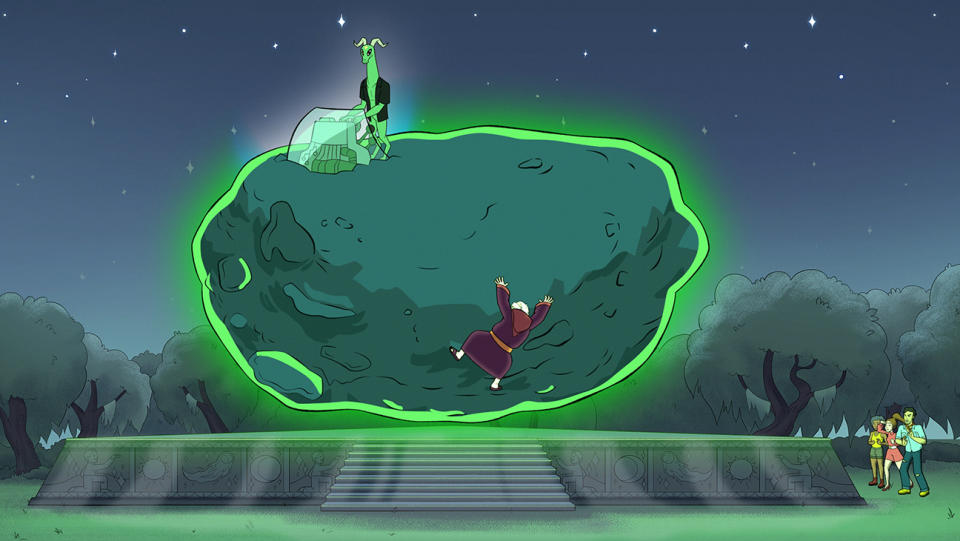
Produced in part by Bandera Entertainment’s Mike Judge, Greg Daniels and Dustin Davis with animation from ShadowMachine, the 10-episode Freeform series, which also streamed on Hulu, comes from the mind of former Saturday Night Live head writer Anna Drezen. It also counts Christine Baranski, Paget Brewster, Kenan Thompson, James Hong, Oded Fehr, Michael Cera, Chris Estrada, Sheryl Lee Ralph, Alan Tudyk, Robert Patrick and Joel Kim Booster among its star-studded season one voice cast.
Drezen, who is also an executive producer on the show, spoke and emailed with The Hollywood Reporter about Praise Petey‘s first season, including how she approached her cult comedy; casting and writing for an animated, adult romance; being an animated series covered by the WGA; how the show’s art style found comedy in a limited budget — while also whipping up backlash; and where the series will go if it gets a season two.
A friend who watched said that a lot about the cult Petey inherits reminded them of an Oregon-based cult that tried to take over a town in the ’80s. But there seemed to be other influences, like Midsommar. What groups inspired the New Utopia cult?
The Rajneeshpuram cult [from Wild Wild Country] was a primary inspiration, your friend is correct. (Laughs.) The original name for this show when it was still a spec script was Wild, Wild Petey. The Mae Mae character is very much inspired by Ma Anand Sheela. But I really thought of this season of TV as a rom-com about a toxic workplace. In the writers’ room, we talked a lot about how every cult has the honeymoon phase at the beginning where it’s all like, “There was just a group of 20 of us wandering around the field.” Then five years later, everyone’s trying to pack the town council and doing a lot of paperwork and a lot of weed whacking and washing dishes. You start off getting love bombed and joining for big idealistic reasons, and then you spend a lot of time peeling potatoes. There’s a real slog that happens. I think anybody who’s been excited about a job and then learned the reality of the job will relate to the show.
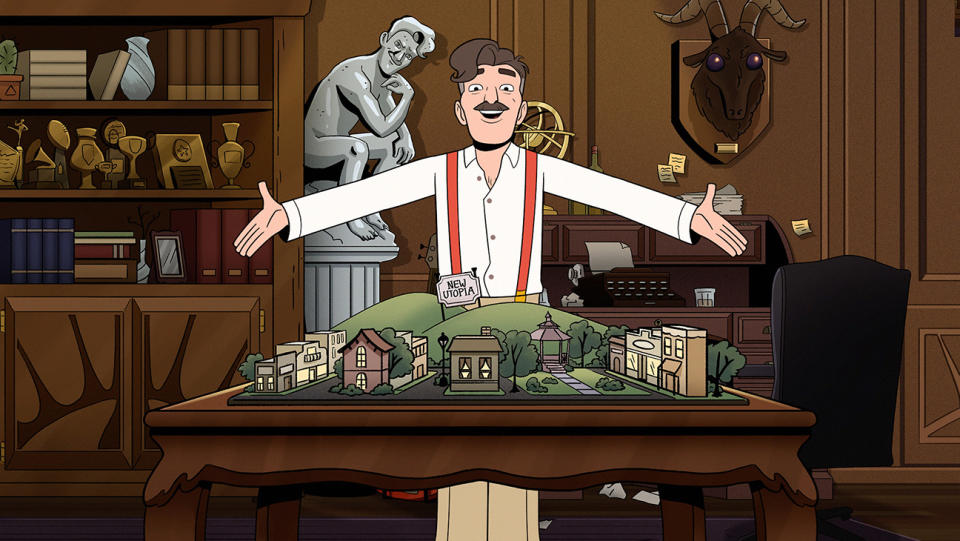
There are obviously weird things about cults that can induce laughs, but cults can also be traumatic, dangerous things. Where was the comedic line for you?
A huge concern of mine going into this was making it clear that we are punching up in the right direction and not, “Look at these dumb trauma survivors.” That was always not at the front of my mind, but not in the back of my mind. I’d say in the middle of my mind. Any pitch that came in that felt a little too harsh, even if it was funny — I wouldn’t get rid of it if was correct and funny. I just tried to find ways to make it right. After a few weeks in the room, we figured out that the comedy engine of this show comes from the mindset of someone who’s doing something that goes against their better judgment, like Jim and Pam [from The Office]. Jim thinking it’ll be fine to see Pam planning her wedding at the office all the time, like “Yeah, I’ll figure it out. It’s fine.” You know it’s not fine. You know it’s unsustainable, and you’re watching because it’s exciting to see the moment at which they start contending with that.
Speaking for myself, I have a lot of magical beliefs. I think when people are trying to change for the better or change something specific about themselves, they’re willing to act against their own self-interest. If I want to put on 40 pounds of lean muscle, I’m going to have to do some stuff that feels unnatural, painful, and weird. I’m waking up at five. I’m drinking egg whites. I’m talking to people I have nothing in common with at a gym that is far from my house. You can get good things out of that. I think that where people go wrong with these cultic groups is thinking that the things that they’re doing that are outside of their own self-interest will pay off.
You described this as a workplace comedy, but Praise Petey also feels like a coming-of-age, self-discovery journey. How did you think about her arc for season one?
At some point, I talked to this showrunner, Lon Zimmet, who put it like, this is a coming-of-age narrative through the lens of a cult. But the big question we had to answer with the pilot was, why would Petey stay here after seeing someone get murdered? That was something that our partners at Freeform were like, “Let’s just make sure we can stay with her as she makes this decision.” (Laughs.) Which is why we added the scene of Mae Mae doing the, “What isn’t a cult? It’s all kind of a cult. In your life in New York, you did these things that were outside your best judgment for reasons you didn’t understand. So what’s the difference?” And then connected it back to, “Your mom doesn’t love you.” (Laughs.) That seemed like a pretty potent combination of love bombing.
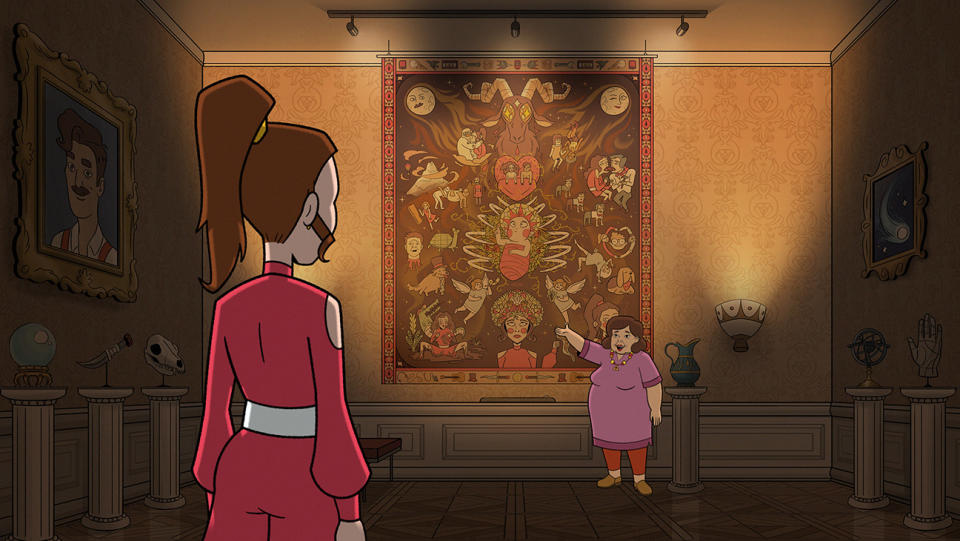
[The New Utopians] take information about your life and use that to keep you around, which was inspired by Scientology’s audit — the E-meter sessions — where it’s basically you telling everything you’re tender about to a person who’s trying to get you to join. Then they say, “Well, do you take yourself seriously as an actor or not? Because you seem like one of those people who is probably just going to quit and move home.” And then you’re like, “What? OK. Now I’m insecure.” The auditing process is just telling us stuff about yourself that we can use as leverage to get you to peel potatoes. We need more weed whackers. (Laughs.) So Petey is an idealistic new manager who thinks she can change corporate culture without realizing that she’s just there to fill a seat, which, I’ve been that person before. And professional life is where your coming of age meets your worldview. It’s the personal and the ideals coming together.
The women of the show are running cults and companies, but also have deep friendships, are frenemies, right-hands or polyamorous wives who demand agency and respect. Were you trying to invert women’s presence in cults and workplaces?
I think we looked at Petey and built the show around her. We did a lot of diagramming out what is a typical cult structure. There’s the leader, and then there are these elders and people under them. Then there are the new recruits who come in. It’s a lot like LuLaRoe. We also watched The Way Down, the Gwen Shamblin documentary on HBO Max. It was interesting because it was this incredibly patriarchal Christian cult that said that women shouldn’t work. It is blessed and correct for men to run the household and make every decision, and for women to follow that. You could see the cognitive dissonance with the idea of, “Well, then why is this cult led by a woman? Why are we listening to her?” But in their structure, they made it very clear that the elders of the church are actually above her, and she did what they said.
So that was informative when we were thinking about how would Petey navigate this. We asked ourselves a lot of questions about what would be the best way to torture Petey. What’s the best way to get our protagonist trying her best and stepping on rakes for 10 episodes? And it filled in from there. We didn’t tend to think super hard about gender. I mean, obviously, we love the idea of this job position that was ergonomically designed for an older man being handed off to a woman, and that you see his buddies and his wives don’t fit when she’s in charge. So then how is she changing it to suit her own desires, and how does she justify that? In episode nine, you see her surrounding herself with this male harem, but justifying it by being like, “No, they’re just helping me.” I think it’s a classic sitcom, character mindset to have impossible magical thinking about what’s possible, give yourself a big problem, and then try to solve it using what you’ve learned.
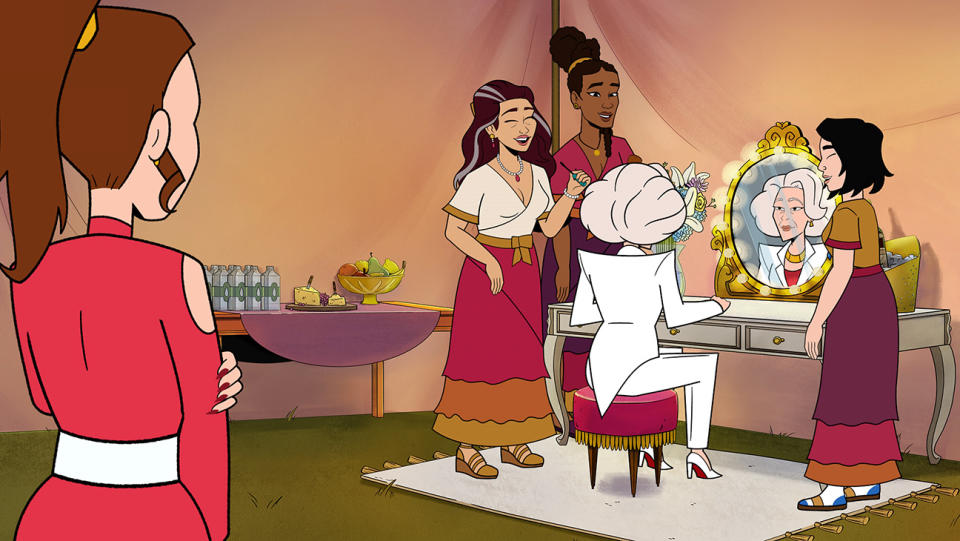
You have got an absolutely brilliant voice cast, and not just with your leads. You had Alan Tudyk show up for an episode playing himself and then get sacrificed. You have an actor from The Mummy, Oded Fehr, in this show.
Pure wish fulfillment on my part for Oded. (Laughs.) We were like, “Who is good at doing gravitas-laden exposition?” The first 10 minutes of The Mummy is just him. It’s just voice-over giving exposition, and he’s incredible at it.
Did you have specific people in mind for these characters? Were you auditioning?
I think we were looking to attach someone really exciting to the Petey role when we were selling this initially and Dustin Davis, my producer at Bandera, which is Greg Daniels and Mike Judge’s company, had met with Annie at some point and said that she was lovely. I’m obviously a huge fan of hers. I was a little concerned that it was too similar to Schitt’s Creek, but in terms of finding someone who’s funny, gets rom-com stakes, can rattle off an insane line quickly and get the joke? You can’t do much better than Annie Murphy. We had such a blast recording with her, and she was so game for anything, which was really fun. Then we built this ensemble around her, like who would be fun to hear her interacting with? Amy Hill was someone that I had in my head for Mae Mae from the very beginning. She is so good in everything that she’s in. She has that comforting, hypnotic, “Come to mama” energy that I think was really important for Mae Mae. (Laughs.)
For Petey’s dad, we wanted somebody who could nail the Rasputin-like, “I’m drawing you into my web while also being a maniac” vibe. My co-showrunner, Monica Padrick, after the first time we recorded Stephen Root turned to me and was like, “Oh, Petey’s dad is insane. Ooooh, OK. That helps. I didn’t know that.” (Laughs.) We initially conceived him as this calculating mastermind and Stephen came in and was like “Whaaaah!” So we were like, “Oh, he’s crazy.” But once he looks you in your eyes, you’ll get it. I also didn’t initially know that his character design would be hot. (Laughs.) Twitter has discovered that Petey’s dad is low-key hot. After the design first came in from Amanda Lake, our art director, Greg Daniels was like, “Does it make sense to you to hear Stephen Root’s voice coming out of this character?” I was like, “I think America is ready for Stephen Root as a hot maniac. I think that’s what we deserve. We’ve been through a lot.”
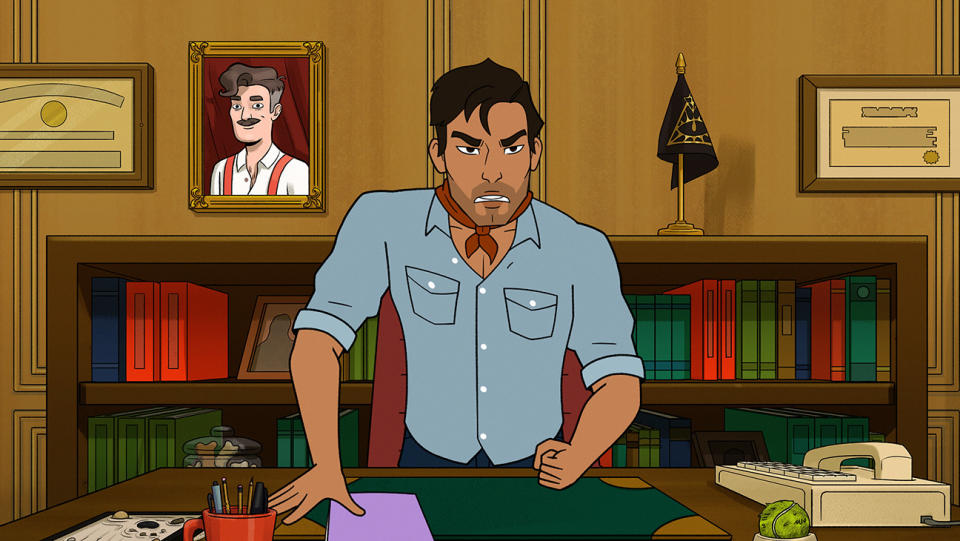
Your leading man is Bandit, voiced by John Cho with a Southern accent. John has previously occupied a space in Hollywood as the hot guy love interest for audiences, but never in this exact way. How did you land on him?
We had a list of hunky-voiced, leading men, and some of them were typical voice-over actors who pop up in everything, and some were unbelievably famous. George Clooney, I don’t know if he was on it, but I think Ben Affleck was on the list. I don’t think Ben Affleck is going to do our cartoon. (Laughs.) I’m sorry. If he were my cousin, I don’t know if he would do it. (Laughs.) It’s also stressful to have an incredibly famous person and be like, “Hey, can you come back and re-record the line? We changed the name of the money in the town.” But I just went through and listened to a bunch of leading men on late-night talk shows just to hear them when they’re relaxed and chatting — to hear the natural flow of their voices.
Then I closed my eyes and tried to picture country hunk while they were talking, and John has the most perfect, soothing voice. You could picture him calming a horse. I think he would be pretty good at that. The idea of him, he just felt really correct. John Levenstein is one of my co-EPs. He worked on Arrested Development and a ton of other classic, very funny shows. He pointed out pretty early on that Bandit is a blowhard and believes things so, so much, so deeply in his heart, and John is just so good [as a person]. My favorite shade of Bandit is when he’s pounding the desk and yelling about ideals. John was such a pleasure to work with. So funny. So talented.
You really live in the rom-com genre, starting with Brian, that plank of wood Petey was engaged to in New York before meeting Bandit. We also see Eliza and Connie (Paris Sashay) become a very cute thing. Why did you want that rom-com element in Praise Petey?
I’m of the opinion that people only like the things they like because characters kiss or might kiss or look like they should be kissed. I don’t know if I’m right. (Laughs.) It’s definitely true for me. I will sit through three Lord of the Rings movies if someone almost-kisses in one. And if the men are mostly wet, I’m in. They don’t have to kiss for three and a half hours, but if they’re dripping wet and wearing wigs, that’s almost a kiss. I love shows like Heart of Dixie and Virgin River, and there’s a Christina Milian movie called Falling Inn Love. Have you seen it?
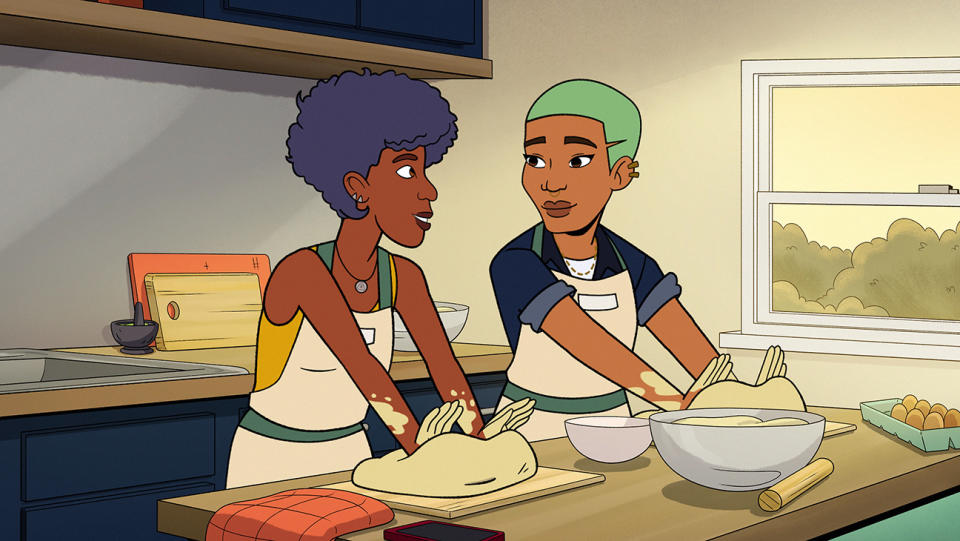
Yes. (Laughs.)
So yeah, it’s just nice to see people in beautiful locations flirting. (Laughs.) I think it’s really fun. I really like mixing that romantic energy with hard jokes. I just think it’s joy-on-joy. It’s really fun to have characters be nervous around each other and try to prove a point, while they also have feelings for each other. I’m like, “What else would you be writing if it isn’t characters having crushes on each other? Like, why would anyone care?” (Laughs.)
Rom-com elements aren’t entirely new in Western animation, but animated sex scenes with that rom-com tone are rare. How do you stage your animated love scene montage?
This was a real, figuring-it-out-as-we-go thing. (Laughs.) When we got on the design meeting, I didn’t know that they were going to be showing us naked characters one day. They were like, “Well, if they’re holding a bedsheet we need to know where Petey’s nipples are physically, so we can draw the rest of her.” I was like, “These are my children, how are we doing this? (Laughs.) This is so weird. Why does the cartoon have pubes? (Laughs.) Doesn’t need that. It’s cartoon.” It was so funny, too, because we would get these standards and practices emails, and it was the first time that Freeform was noting animation, so their notes would be, “Please ensure actors’ nipples and buttocks are covered.” I was like, come on. It’s a cartoon. We just won’t draw them … and then they were fully drawn. (Laughs.)
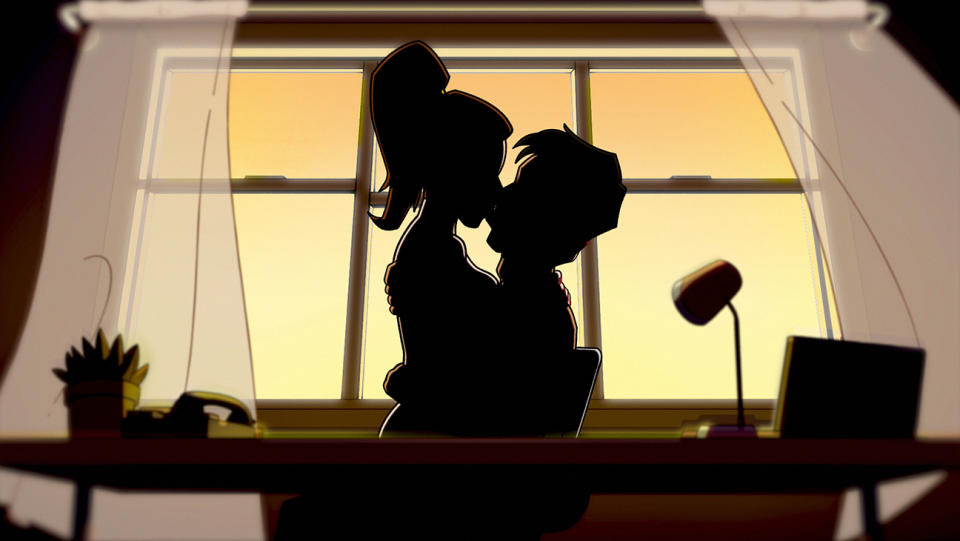
That was me and Pete Merryman, who is the supervising director of the show and is so much fun to work with. He comes from the South Park universe. The South Park and SNL handshake is very, very similar. But we tried to lighten it. Instead of playing the sex for laughs, we committed hard to the romantic elements and then contrasted it with other stuff that is not that so that it’s like, isn’t it so funny that there’s kissing while they’re preparing for doomsday? Instead of being like, “Gross! Kissing.” It was calibrating how gross to make it. There’s a scene where Petey and Bandit are silhouetted in front of a window and the first pass of that it’s not silhouetted because lighting is the last thing that happens. So it’s just like full people fucking in an office. I was like, “What are we doing? Are we making porn?” (Laughs.) This comes on literally one second before the 700 Club. What are we actually doing here? We’re going from Praise Petey to the following telecast does not reflect … (Laughs.)
You’ve got reality TV elements, sci-fi and aliens, some horror moments, true crime podcasting in the finale, and a toe dip into the musical with Petey walking around town like Belle from Beauty in the Beast to a song about her getting a UTI. Can you talk about all that genre mixing?
We talk a lot about genre crossover. I think those kinds of shows like CW’s Riverdale are hugely informative to how we shoot the show, the look of it, the pacing, the music element. Kathryn Bostic is our composer and the music is just so beautiful and real and present in such a dumb show, which is such a fun mix. I grew up on The X Files and The Mummy is my favorite movie of all time. Lore, backstory, sci-fi, the undead, sacred books, hidden chambers, torches — these are all things that I love thinking about, looking at and writing.
The art styling for this show is also really great, in part because it feels different from what we’re used to seeing from some adult animation. What inspired that?
They’re definitely idealized body types, but they’re proportional to people. And there are some talking animals, but our goal was to make it look like these CW night soaps, and I think we nailed it. I think [Charlie Kirk] talked about Praise Petey when the trailer dropped, and a lot of people were very concerned that we were a Disney show that was trying to make kids watch Illuminati human sacrifice content. I knew something was up when there were 3 million views on the trailer. I was like, “I don’t think anyone’s this excited.” (Laughs.) A first-season animated show that isn’t IP or franchise? I think maybe something’s really wrong. (Laughs.) One of the complaints was, “I can’t believe you’d make this for kids!” I was like, it’s definitely not for kids. I think with streaming it becomes harder. I know that there are probably parental controls you can put on it, but everything’s all mish-mashed together. But yeah, this is not for kids.
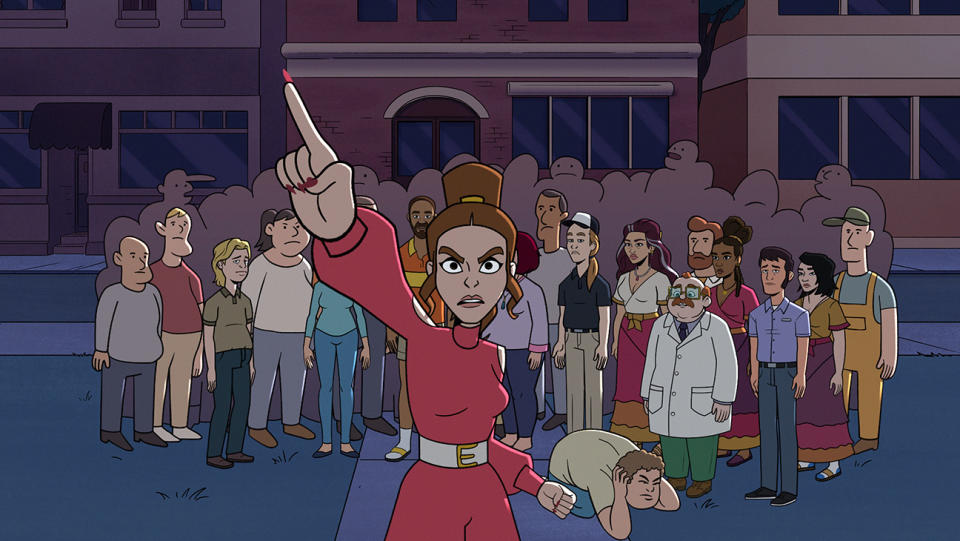
One thing that’s really comedically brilliant is how you deliver a different styling with your fore, middle and background characters. What was the reasoning behind that?
That was stuff that came to me from Pete and Amanda and our other folks on the production side at ShadowMachine. The short answer is resources. It’s a first-season show, and part of a first-season animated show is that costs are lower than the average show would be. Something that I didn’t know coming into this space is that crowds are profoundly time-consuming and the more people you have onscreen, the more people you have to have working and the more hours they’re working. So this was something I think went really perfectly with what I was envisioning visually, which is for this to look like a pretty, two-dimensional cartoon. I wanted to be able to focus on our characters’ facial expressions and comedy timing, and less on making the whole crowd articulated. So that’s where we landed because there are times when you need to get a sense of how many people are there.
In animation, it’s easier if there are fewer people, but if Petey’s giving a speech to three characters, this is a story about how no one showed up. So this bubble crowd was designed by Amanda and, I think, Brad Lewis, one of our character designers. Then we would have people in between the bubble crowd and our rigged characters that were halfway in between — like a tadpole version. You can see they’re drawn, but they’re not really moving, and they have dot pupils. At first, we just had the rigged characters and then the bubble crowd right behind them. I think in [episode three] there is one scene where it’s just rigged characters and then bubble crowd, and you’re like, “What the fuck?” (Laughs.) I think after episode four or five, we realized you need to have another line of characters in front of it. It can’t just be Petey, Bandit, and then a group. But I find it to be very charming and very appealing to look at.
Your first season has wrapped with the aliens being real and Petey having made a big mess of things with Eliza and Bandit in her reimagining of the cult post-comet. Where do you see a possible season two going?
I would love to write more episodes with these characters. I think they’re so fun, and it’s really nice to play in this world. I think that Petey will now be a lot more committed to doing the wrong thing than she was, but also doing it in a way that feels like her and that she can live with. I think in season two we’re going to see her taking bigger swings; really grabbing the bull by the horns; trying to put her stamp on this town in a real way. Not just putting band-aids on her dad’s stuff. That’s something that she says in [the finale]. “I’m done with doing band-aids to work around your crap.” She’s really going to be working with what she has and making bigger moves.
I see a lot of plot-driven episodes, but it’ll still be like season one, where it’s pretty episodic. It’s plot-y but like Rick and Morty where there’s a lot of lore and plot, but whatever you need to understand it is within the context of the episode itself, so you can watch it in whatever order. I think we’ll be tracking the big reveal that happens at the end of [episode 10], and Petey, Bandit, and Eliza’s new little pack that they have — the three of them, having seen what they’ve seen. Petey is now double-committed to this town. She has a lot invested in it. People in New York know she’s here. We’re also going to be tracking that reporters are getting wind of this scam woman. I think it’s going to be really similar to season one in the sense that these are people who are engaging in magical thinking in order to not have to blow up their lives.
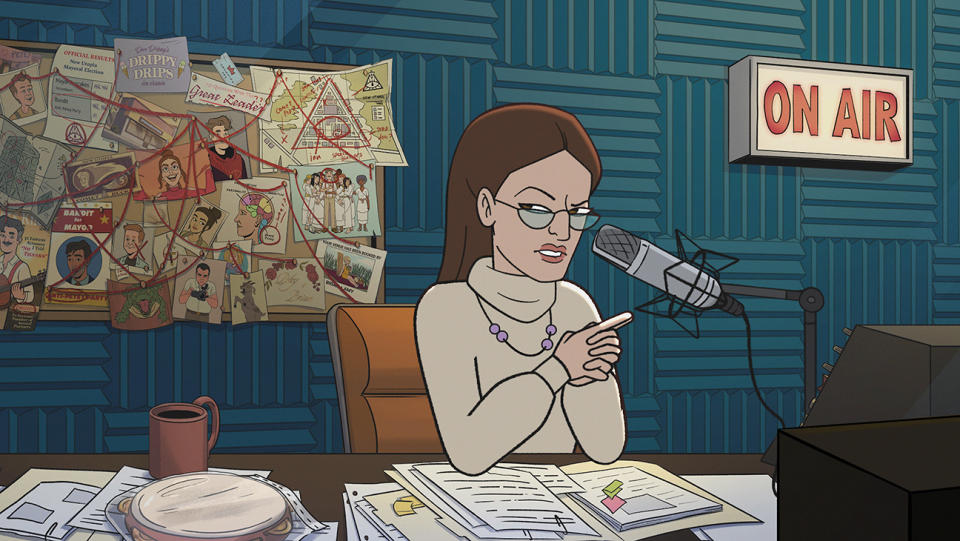
You’ve written for live-action scripted shows, but this is your first time writing animation. How, if at all, has your experience with Praise Petey reinforced why animation writers — most of whom are not covered under WGA contracts — should have equal standing with other writers in the industry?
This show was covered by the WGA. It was a hard-won battle to get it covered, and I was so relieved that my producers and I were able to make it work. So many animated shows are being told they’ll only be developed as non-guild, so for me, it was a choice between no health insurance and no show at all. Fortunately, we were able to partner with 20th Animation to ensure the show could proceed as WGA, which was something that happened very late in the development process.
Every production goes through the “how can we save a little bit of money” process, and that gap should never be covered by asking writers to go without health insurance or fair compensation for their contributions. I can tell you as someone who moved from live-action sitcoms to animation that the writing process is identical up until the point of actual production. No exec is going to be like “Well, if this were live-action, we would ask a bunch of questions about character development and theme and tone and story structure, but since it’s cartoons, who cares.” They want all the same thoughtful work that goes into live action, and I could not have navigated the scripting process without the experience of Monica Padrick and John Levenstein, my co-showrunner and co-EP, who I would not have been able to get to work on the show if it weren’t union.
Animation workers in general are squeezed to death more and more every year, and that includes writers doing three-week mini rooms. We need to stop trying to save money at the level of people with roommates. Having the show be guild means that my writers have about two years’ worth of health coverage and residuals to help keep them afloat until the next room opens. One of our writers had a baby toward the end of the room. It was a relief to know that she had the kind of compensation and health coverage to be able to do a big life thing like that. It’s a cute baby!
Interview edited for length and clarity.
This interview was coordinated through Anna Drezen’s personal PR in accordance with a WGA ruling after the writers strike that began May 2.
Praise Petey season one is currently streaming on Hulu.
Best of The Hollywood Reporter

